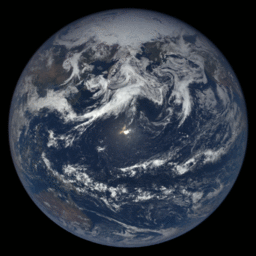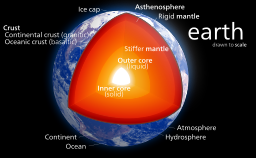Solar System
Earth

It is the earth which is our home. Our earth is a very unique and special planet in the solar system. It is only earth in our solar system where water is present. Earth has soil on which plants grow which gives us food. The surface of earth is covered by water and rock. The one third part of the earth is covered with water. Because of reflection of sunlight from water surface our earth appears blue from space. This is the cause that our earth is called BLUE PLANET. Earth has only one satellite called moon. Moon revolves round the earth.

Earth's Atmosphere
There is a natural type of blanket of air around the earth, called the atmosphere. Atmosphere protects earth from ultraviolet rays coming from sun. Ultraviolet rays are very harmful for living things whether it is plants or animals, it can cause many diseases.
Earth: Position in Solar System
Earth is the third planet according to increasing distance from sun. This distance is very much suitable for existence of life. It is neither too far nor too close to sun. Very close planet to the sun is mercury, which has no atmosphere because of much heat. And very far planet to the sun is Neptune, which is very cold.
Earth: Shape and Appearance
The shape of earth is like a sphere. It is flat at its pole, the shape of earth resembles like an orange, i.e. approximates an oblate spheroid. The earth looks like a beautiful blue and green spherical ball from the space. The surface of the earth appears to be flat. The surface of earth looks so from earth because of its large size.
Earth: Various Features
The surface of the earth has various features such as oceans, rivers, mountains, and valleys. About 2/3 of earth surface is covered by water. Rest 1/3 i.e. about 30% of earth surface is in the form of land. 5.8% of total surface of earth is in the form of mountain and 5.84 % of the surface is in the form of snow covered area.
Mount Everest is the highest mountain on the earth, and its highest peak is 8848 meter above the sea level. Mount Everest got its popular name after Colonel Sir George Everest, an English and was the Surveyor General of India from 1830 through 1843. In Tibetan Mount Everest is called ‘Chomolungma’ which means ‘Holy Mother Peak’.
Mariana Trench is the deepest point on earth. Mariana Trench lies in the ocean of Pacific to the east of Mariana Islands. Mariana Trench is about 2550 km long.
Earth: Internal Structure
Earth's internal structure has been mainly divided into three different layers these are Crust, Mantle, and Core.

Crust:
Crust is outer most layer of earth. Crust is ranges from 5 to 70 km from earth surface. Crust is made of rocks. Continents and oceans lie in this layer.
Mantle:
Mantle is the middle layer. It is about 2900 km thick. Its upper part is made of solid rock and the lower part consists of molten rock. Mantle is the thickest part of earth.
Core:
It forms the centre of the earth. It has two parts outer core, inner core.
Outer Core: Outer core is made of iron, nickel in the molten state.
Inner core: The inner core is solid ball made up iron.

Earth: Some Important Facts
Earth is the only planet in our solar system which supports life system.
Name: Earth is known as Blue Planet also.
Size: Diameter of earth is 12742 km and radius is 6371 km.
Distance: Earth is at a distance of 149.6 million kilometer from sun.
Position: Earth is the third planet from sun.
Days: One day on earth is equal to about 24 hour.
Year: One year on earth is equal to about 365 days.
Rotation: Earth completes one rotation on its axis in about 24 hours.
Revolution: Earth completes one revolution round the sun in about 365 days.
Moon: Earth has one natural satellite called Moon or Luna.